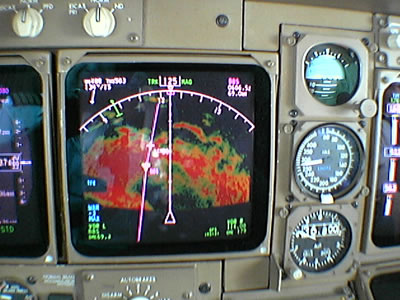 |
Weather is a topic
that nearly everyone talks about each day. I imagine that
just about everyone would like to live and work in warm
sunshine. Pilots would love to fly in continuous warm sunny
weather. Hawaii comes to mind. Only problem is that even
Hawaii suffers rain and storms. Pilots have to learn how to handle different weather situations. Flying at
night should be mentioned here as well because flying
at night involves flying
with a reduced visibility.
This really involves instrument flight. This is covered
under the menu item "Instrument Flight".
|

|
|
Definition: one
knot is one nautical mile per hour. This is the unit used
for speed aboard airliners. One nautical mile is defined
as one minute of arc of latitude. There are 60 minutes
in one degree. Therefore the distance from the Equator
to the
North or South Pole would be: 90 (degrees) multiplied by
60, which equals 5,400 nautical miles. As a comparison
with other units of measurement: 100 knots equals 115 miles
per hour, equals 185 kilometres per hour.
There is a definite relationship
between speed in knots and navigation. See "Navigation" option.
|
 |
|
Wind: An
aeroplane flies on airspeed, the only difference that wind
makes is to affect groundspeed. In still air a B747 flying
at 500 knots (airspeed) would cover 500 nautical miles
in one hour. If this B747 had a tailwind of 100 knots its
effective groundspeed would be 600 knots, that is, the
plane would cover 600 nautical miles in an hour.
Conversely, if this B747 had a headwind
of 50 knots its effective groundspeed would be 450 knots
and travel 450 nautical miles in one hour.
|
|
|
On takeoff
and landing pilots prefer to fly into wind because
the groundspeed is less than the airspeed and hence the
distance required on the runway is less. The only real
problem that wind creates in this phase of flight
is if the wind blows across the runway, that is; crosswind.
Each aeroplane has a definite crosswind limit.
Typically for a B747 the crosswind
limit is 30 knots. If the crosswind is stronger than this
pilots are not authorised to land or takeoff. I should
mention that this limit is reduced on wet runways and during
poor visibility.
|
|
Rain or
Snow
Rain and snow cause visibility problems and also can
make the runway slippery. Visibility problems are covered under "Instrument
Flight". Slippery or contaminated runways cause problems
on both takeoff and landing. They can reduce the acceleration
on takeoff and also make stopping difficult on landing. There
are limits to which pilots can operate their planes in these
conditions and there are performance penalties that must be
taken into account before a plane lands or takes-off. For example,
on landing the distance required to stop on a wet runway is
15% greater than that required on a dry runway. |
 |
|
Landing
and take-off
When stopping a large plane such
as B747 pilots have at their disposal: autobrakes, manual
brakes, and reverse thrust.
Before take-off and landing the
pilot checks the runway length available and applies an
adjustment for a contaminated runway.
|
|
The
pilot panel here shows the weather ahead.
The white triangle is the plane. Here I am 50 nm off to the right of track
avoiding a monsoon on the East coast of India.
The plane is at 37,000 feet. Refer to instrument flight page for more information
on various pilot panels.
The radar here is pointed down at five degrees. Normally
we use one or two degrees. Place your mouse over the picture
to see a 1-2 degree view.
You can see why I have chosen to deviate to give my passengers
a smooth flight. The 1-2 degree view shows the clear path
as we over- flew the lower weather displayed on the 5 degree
view. |
|
 |
|